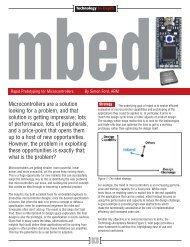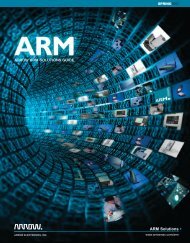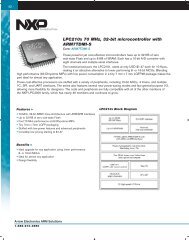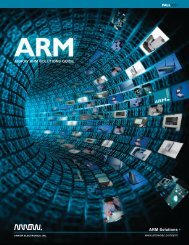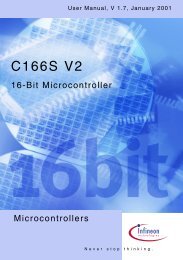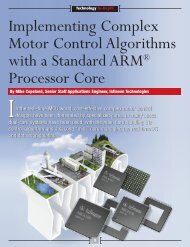Understanding the Latest Open-Source Implementations of Real ...
Understanding the Latest Open-Source Implementations of Real ...
Understanding the Latest Open-Source Implementations of Real ...
You also want an ePaper? Increase the reach of your titles
YUMPU automatically turns print PDFs into web optimized ePapers that Google loves.
Technical ViewIt <strong>the</strong>refore allows all applications implementedon Xenomai skins to run directly on a monolithickernel. In o<strong>the</strong>r words, Xenomai 3.0 acts as anabstraction layer over <strong>the</strong> regular Linux kernel,providing this kernel’s real-time capabilities to itsapplications through <strong>the</strong> various skins. Xenomai3.0 only requires <strong>the</strong> standard POSIX API, sothat no patching or porting to particular kernelversions is needed.This gives <strong>the</strong> developer <strong>of</strong> applications for Xenomaia useful choice: to run <strong>the</strong> applications under asmall, lightweight and industry-proven real-timekernel, or under a preemptible Linux monolithickernel. It is important to understand, however,that <strong>the</strong> second choice means that all real-timecapabilities have to come from – and are only asgood as – <strong>the</strong> underlying Linux kernel itself.Dual Kernel Versus Native PreemptionEach method has its own benefits. The co-kernelapproach has <strong>the</strong> advantage that <strong>the</strong> real-timeapplication is totally independent <strong>of</strong> <strong>the</strong> Linuxkernel and only depends on <strong>the</strong> real-time kernel,scheduler and abstraction layers. There is a clearseparation between <strong>the</strong> real-time and non-realtimedomain. This simplifies maintenance, timingand safety certification.Porting to new CPU architectures is also easy,because only <strong>the</strong> abstraction layers have to beadapted. An interrupt abstraction layer patch,however, is always specific to a certain kernelversion, and patches are only available forselected versions <strong>of</strong> <strong>the</strong> <strong>of</strong> <strong>the</strong> mainline kernel.Under <strong>the</strong> single-kernel approach with <strong>the</strong> Linux/PREEMPT_RT patch, a POSIX real-time APIallows real-time applications to be developed in<strong>the</strong> GNU/Linux user-space, and to benefit fromall development, debugging and pr<strong>of</strong>iling toolsavailable <strong>the</strong>re.At some point in <strong>the</strong> future, <strong>the</strong> RT_PREEMPTpatch will be completely merged into <strong>the</strong> mainlinekernel, and <strong>the</strong>n it will be simple to compile areal-time kernel for any supported system. Then,however, every modification to <strong>the</strong> operatingsystem, such as kernel patches or new drivers,might influence <strong>the</strong> system in a perhapsundesired way. Therefore <strong>the</strong> system will haveto be re-qualified and possibly re-certified aftersuch modifications.Ano<strong>the</strong>r drawback is that <strong>the</strong> Linux/PREEMPT_RTentails higher worst-case latencies than adual-kernel system.In <strong>the</strong> author’s opinion, using <strong>the</strong> POSIX real-timeAPI is <strong>the</strong> best answer to <strong>the</strong> problem <strong>of</strong> decidingbetween <strong>the</strong> two approaches. Depending on <strong>the</strong>specific requirements <strong>of</strong> <strong>the</strong> end product, POSIXreal-time applications can ei<strong>the</strong>r run on Xenomai’sdedicated real-time kernel or on a single Linux/PREEMPT_RT kernel.Performance Evaluation in <strong>the</strong> <strong>Real</strong> WorldSo just how ‘real’ is <strong>the</strong> real-time performance<strong>of</strong> Linux? Below is a method to get a quick firstimpression <strong>of</strong> <strong>the</strong> latency <strong>of</strong> any given system.The tool cyclictest is used to schedule a task with<strong>the</strong> highest priority every 10ms. The tool knowswhen this task is expected to run and calculates<strong>the</strong> latency or deviation from this expected time.Table 1 shows <strong>the</strong> results <strong>of</strong> a test run on aFreescale i.MX53 ARM Cortex-A8 processoroperating at 1GHz. It ran Linux kernel 2.6.38 from<strong>the</strong> DENX Linux tree. Two different test systemswere set up.S_CPRE: standard kernel withCONFIG_PREEMPT (“Preemptible Kernel(Low-Latency Desktop)) enabled./cyclictest –m -n -p99 -t1 -i10000 -1360000S_XENO: Kernel + Xenomai 2.6.0-rc4 + I-Pipe1.18-03./cyclictest -n -p99 -t1 -i10000 -1360000SystemLatency/µsS_XENOS_CPRE1st runS_CPRE2nd runMinimum 2 27 13Average 43 88 81Maximum 58 415 1829Table 1: Cyclic test <strong>of</strong> single- and dual-kernel Linux systemsThe average latency shows <strong>the</strong> typical values thatcan be expected from this system. For developers<strong>of</strong> hard real-time applications, however, only <strong>the</strong>maximum latency is <strong>of</strong> interest. The table clearlyshows <strong>the</strong> superior performance <strong>of</strong> a dual-kernelsystem.ConclusionWhen <strong>the</strong> entire PREEMPT_RT patch has goneinto mainline Linux, it will be <strong>the</strong> method <strong>of</strong> choicefor ordinary real-time applications. Xenomai 3.0will <strong>the</strong>n allow easy porting <strong>of</strong> existingapplications to a single, real-time Linux kernel.A dual-kernel approach will continue to be mostappropriate for hard real-time requirements.For developers <strong>of</strong> new applications, <strong>the</strong> use <strong>of</strong> <strong>the</strong>POSIX API is highly recommended whe<strong>the</strong>r <strong>the</strong>yare implementing a single- or dual-kernel system.In <strong>the</strong> near future, <strong>the</strong> trend to use multi-coreprocessors will allow for new solutions to <strong>the</strong>problems discussed in this article. For example,it is already possible in mainline GNU/Linux toassign interrupts to a CPU core and to keep nonreal-timetasks away from this core. Interestingly,<strong>the</strong>refore, a multi-core system nullifies <strong>the</strong>performance advantage <strong>of</strong> <strong>the</strong> dual-kernelapproach. An asymmetric CPU such asFreescale’s Vybrid processor family (using acombination <strong>of</strong> ARM Cortex-A5 and Cortex-M4cores) <strong>of</strong>fers <strong>the</strong> option <strong>of</strong> running multipleoperating systems, each optimised for differentfunctions, to even fur<strong>the</strong>r improve hard or s<strong>of</strong>treal-time performance.* POSIX is a series <strong>of</strong> IEEE standards that helpensure compatibility across operating systems bydefining a series <strong>of</strong> application program interfaces(APIs), functions and command-line shells foruse by <strong>the</strong> OS. Many embedded OSs are POSIXcompliant,including VxWorks, Linux, MQXand QNX.1.800.FUTURE.1 • www.FutureElectronics.com27



